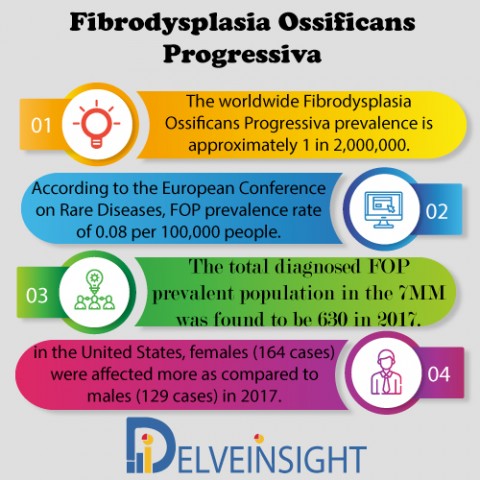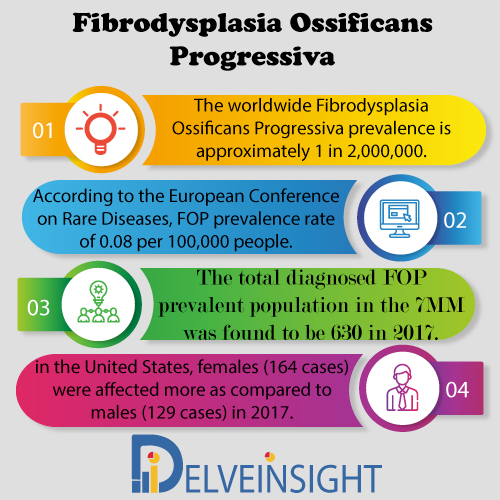Fibrodysplasia Ossificans Progressiva Market Insight, Market Size, Epidemiology, Leading Companies, Emerging and Marketed Therapies By DelveInsight
Albany, US – DelveInsight has launched a new report on Fibrodysplasia Ossificans Progressiva Market Insights, Epidemiology and Market Forecast-2030
DelveInsight’s “Fibrodysplasia Ossificans Progressiva Market Insights, Epidemiology, and Market Forecast-2030” report delivers an in-depth understanding of the Fibrodysplasia Ossificans Progressiva, historical and forecasted epidemiology as well as the Fibrodysplasia Ossificans Progressiva market trends in the United States, EU5 (Germany, Spain, Italy, France, and United Kingdom) and Japan.
The Fibrodysplasia Ossificans Progressiva market report provides current treatment practices, emerging drugs, Fibrodysplasia Ossificans Progressiva market share of the individual therapies, current and forecasted Fibrodysplasia Ossificans Progressiva market Size from 2017 to 2030 segmented by seven major markets. The Report also covers current Fibrodysplasia Ossificans Progressiva treatment practice/algorithm, market drivers, market barriers and unmet medical needs to curate best of the opportunities and assesses the underlying potential of the market.
Key benefits of the report
1. Fibrodysplasia Ossificans Progressiva market report covers a descriptive overview and comprehensive insight of the Fibrodysplasia Ossificans Progressiva epidemiology and Fibrodysplasia Ossificans Progressiva market in the 7 MM (the United States, EU5 (Germany, Spain, France, Italy, UK) & Japan.)
2. Fibrodysplasia Ossificans Progressiva market report provides insights on the current and emerging therapies.
3. Fibrodysplasia Ossificans Progressiva market report provides a global historical and forecasted market covering drug outreach in 7 MM.
4. Fibrodysplasia Ossificans Progressiva market report offers an edge that will help in developing business strategies by understanding trends shaping and driving the Fibrodysplasia Ossificans Progressiva market.
Request for sample pages here -> https://www.delveinsight.com/sample-request/fibrodysplasia-ossificans-progressiva-fop-market

Fibrodysplasia ossificans progressiva (FOP) is a disorder in which muscle and connective tissue such as tendons and ligaments are gradually replaced by bone (ossified), forming bone outside the skeleton (extra-skeletal or heterotopic bone) that constrains movement. This process generally becomes noticeable in early childhood, starting with the neck and shoulders, and proceeding down the body and into the limbs. Mutations in the ACVR1 gene causes fibrodysplasia ossificans progressiva. The underlying genetic mutation in FOP alters the signals that regulate the induction of cell differentiation leading to bone formation. The symptoms begin in the first decade of life with episodes of painful inflammatory soft tissue swellings. Gradually, there occurs restriction of motion at various joints, severely limiting the activities of daily living and the quality of life of such patients by the third decade of life.
According to the International Fibrodysplasia Ossificans Progressiva Association (IFOPA), Fibrodysplasia Ossificans Progressiva is one of the rarest and most disabling genetic conditions known to medicine. FOP causes the soft tissues to transform permanently into the bone; these bones aberrantly grow in the muscles, tendons, ligaments, and other connective tissues, forming bridges of extra bone across the joints. Presently, there is no definitive medical treatment for FOP, and the only management strategy is supportive in nature. The current management considerations are classified as Class I, Class II, and Class III medications along with few muscle relaxants and special medical considerations including injury prevention, scalp nodules, maintaining respiratory health and capacity, Infection precautions, particularly during the flu season. Also, the market holds substitutes for Acute; Chronic Pain Management in FOP. The Class I medications are widely used to control symptoms of acute flare-ups in FOP (swelling and pain), or chronic arthropathy with minimal side effects generally. Short-term use of high-dose corticosteroids and the use of non-steroidal anti-inflammatory drugs (NSAIDs) and COX-2 inhibitors form the major categories. The coherent use of corticosteroids early in the course of an FOP flare-up is chiefly based on its effective anti-inflammatory effects. High- dose glucocorticoids have limited use but are most effective in the management of the early inflammatory flare-ups affecting major joints of the appendicular skeleton and jaw, mainly when used immediately after the onset of a flare-up. Widespread favorable anecdotal reports from the FOP community suggest that a brief 4-day course of high-dose corticosteroids begins within the first 24 h of a flare-up, and may help reduce the intense inflammation and tissue edema seen in the early stages of the disease. The use of corticosteroids should be constrained to the exceptionally early symptomatic treatment of flare-ups that affect major joints (e.g., hip), the jaw, submandibular area, etc. It can also be used for the prevention of flare-ups following major soft tissue injury (severe trauma) followed by the prevention of flare-ups in emergent, elective, major or minor surgeries such as dental surgery, hypospadias repair, appendectomies, etc. (peri-operative use) as they may decrease the likelihood of HO. A typical dose of prednisone for acute flare-ups is 2 mg/kg/day (up to 100 mg), administered as a single daily dose for not more than 4 days. The medication should be given in the morning, to have the least suppressive effect on the hypothalamic- pituitary-adrenal axis. Besides, Selective cyclo-oxygenase-2 (COX-2) inhibitors and non- steroidal anti-inflammatory medications (NSAIDs) may have a role in the management of FOP symptoms. Traditional NSAIDs such as aspirin, ibuprofen, and indomethacin hinder the formation of both physiological and inflammatory prostaglandins. On the other hand, selective cyclo- oxygenase-2 (COX-2) inhibitors primarily obstruct inflammatory prostaglandins and leave most, but not all, of the physiological prostaglandins relatively intact. Presently, the COX-2 inhibitor celecoxib (Celebrex), as well as, etoricoxib (Arcoxia) is available in many countries, and exhibits reduced gastrointestinal risk compared with other NSAIDs.
Drugs covered
- 1. Palovarotene
- 2. Garetosmab (REGN2477)
- 3. BLU-782
- 4. BCX9250
- 5. KER-047
And many others
The key players in Fibrodysplasia Ossificans Progressiva market are:
- Ipsen
- Regeneron Pharmaceuticals
- BioCryst
- Keros Therapeutics
And many others
Table of contents
1. Key Insights
2. Fibrodysplasia Ossificans Progressiva Market Overview at a Glance
3. FOP Disease Background and Overview
4. Fibrodysplasia Ossificans Progressiva Treatment
5. FOP Epidemiology and Patient Population
6. Country Wise FOP Epidemiology
6.1. United States
6.2. EU5 Countries
6.3. Germany
6.4. France
6.5. Italy
6.6. Spain
6.7. United Kingdom
6.8. Japan
7. Unmet Needs
8. Fibrodysplasia Ossificans Progressiva Emerging Drugs
8.1. Key Cross Competition
8.2. Palovarotene: Ipsen
8.3. Garetosmab (REGN2477): Regeneron Pharmaceuticals
8.4. BLU-782: Ipsen
8.5. BCX9250: BioCryst
8.6. KER-047: Keros Therapeutics
9. Fibrodysplasia Ossificans Progressiva 7 Major Market Analysis
10. The United States Market Outlook
11. EU-5 Countries: Market Outlook
11.1. Germany
11.2. France
11.3. Italy
11.4. Spain
11.5. United Kingdom
12. Japan: Market Outlook
13. Market Drivers
14. Market Barriers
15. Appendix
16. DelveInsight Capabilities
17. Disclaimer
18. About DelveInsight
Request for sample pages here->https://www.delveinsight.com/sample-request/fibrodysplasia-ossificans-progressiva-fop-market
Related Reports:
DelveInsight’s Fibrodysplasia Ossificans Progressiva (FOP) – Epidemiology Forecast 2030 report delivers an in-depth understanding of the disease, historical, and forecasted epidemiology of Fibrodysplasia Ossificans Progressiva (FOP) in the United States, EU5 (Germany, France, Italy, Spain, and the United Kingdom), and Japan.
Fibrodysplasia Ossificans Progressiva (FOP) Pipeline Insight, 2020 report by DelveInsight outlays comprehensive insights of present clinical development scenario and growth prospects across the Fibrodysplasia Ossificans Progressiva (FOP) market.
Media Contact
Company Name: DelveInsight Business Research LLP
Contact Person: Yash Bhardwaj
Email: Send Email
Phone: 9193216187
Address:304 S. Jones Blvd #2432
City: Las Vegas
State: NEVADA 89107
Country: United States
Website: https://www.delveinsight.com/



